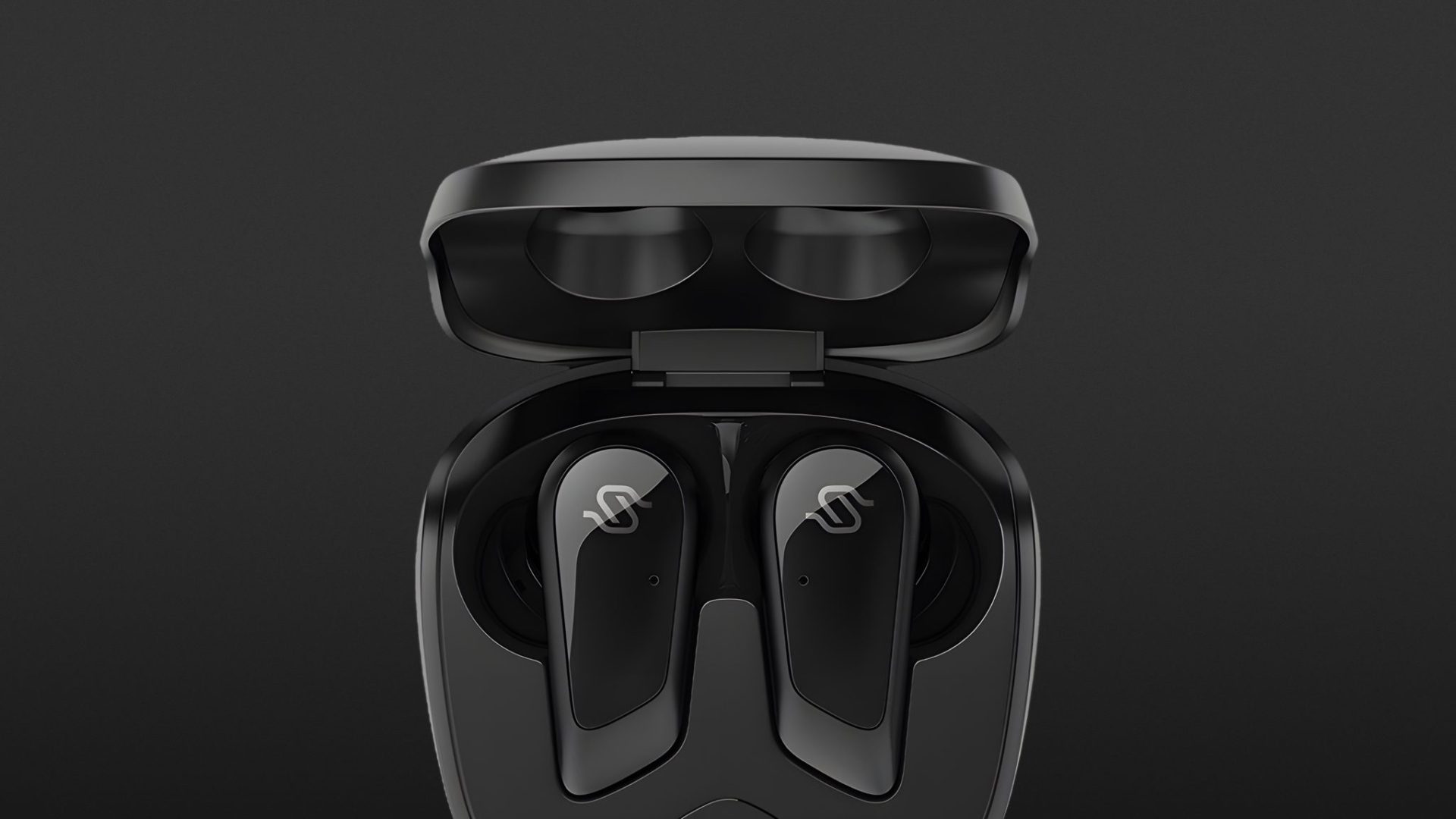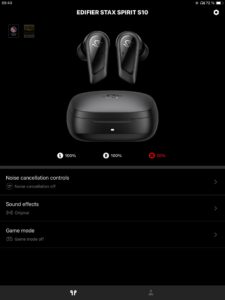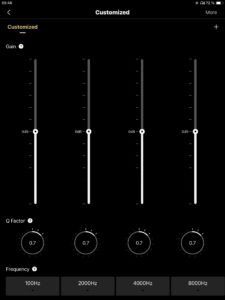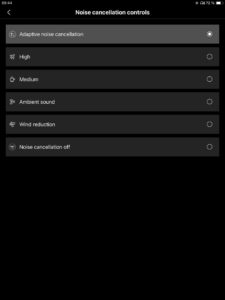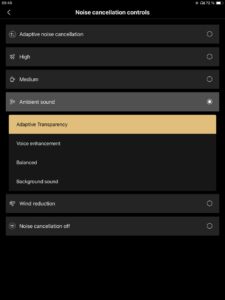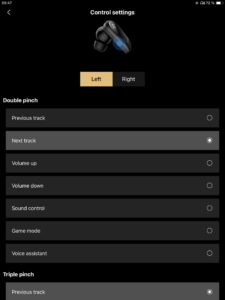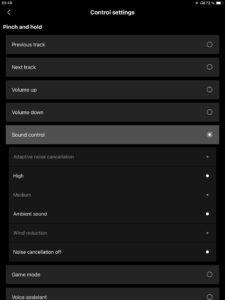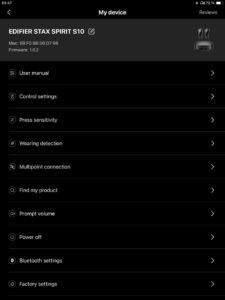The Edifier Stax Spirit S10 combines a planar magnetic driver system with flexible ambient noise control, offering both adaptive noise cancellation and an adaptive transparency mode. In addition to Bluetooth 5.4 and high-resolution audio codecs, they also feature the new technical standards of the Snapdragon Sound Technology Suite.
- Support for AAC, aptX, aptX HD, aptX Adaptive, aptX Lossless, LDAC and LHDC
- Adaptive ANC and transparent mode
- Multipoint connections
- Quick charge function
- Comfortable fit
- IP54 dust and splash-proof earpiece and charging case
- Cannot be switched on and off manually
- Quite sensitive to wind from the sides
- Loss of volume in electrostatic mode
The futuristic design of the Edifier Stax Spirit S10, with its long, wide stems, is undoubtedly eye-catching, but despite the larger housing, they are comfortable to wear for long periods of time and, at seven grams per side, are not overly heavy. On the downside, the materials used for the earpieces and charging case are largely plastic. On the other hand, the IP54 dust and splashproofing of the in-ears and case should be an advantage for mobile use.
Battery life of the Edifier Stax Spirit S10
In standard mode, the True Wireless in-ear headphones will last six hours at high volume when using AAC. If you use the noise cancelling function continuously at high volume, you can expect four hours and 15 minutes. While a fifteen-minute quick charge will give you a good two hours (without ANC), the headphones can be fully recharged in 70 minutes. This can be done three times in the charging case before an external power source is required, giving a total runtime of around 24 hours in basic mode and 17 hours in ANC mode. The case’s battery reserve is also restored after 95 minutes, for which a USB-C to USB-A charging cable is supplied.
Bluetooth Specifications
In addition to the latest Bluetooth 5.4 standard, the Edifier Stax Spirit S10 supports multipoint connections and Google Fast Pair for fast pairing with Android devices. The choice of audio codecs is also very wide, with AAC, aptX, aptX HD, aptX Adaptive, aptX Lossless, LDAC and LHDC 5.0. There are also options for 32 kHz wideband telephony with Qualcomm’s aptX Voice technology and a latency-reduced gaming mode for computer or mobile games and movies.
How to control the Edifier Stax Spirit S10
These in-ear wireless planar headphones have a pressure-sensitive control that is easy to use and reliable thanks to its wider design. The only thing you need to be careful of is a quick sequence of multiple presses to avoid misinterpretation, which is easily achieved with a little practice.
Press and hold is supported, as well as one to three presses, with the assignment largely configurable via the handset’s app connection. Only the single press is not configurable and is reserved for controlling playback and answering and ending calls. Otherwise, functions such as skip forwards or backwards to track selection, volume control, voice assistant, switching between basic, ANC and transparency mode and (de)activating gaming mode are available.
What is missing, however, is the ability to switch the headphones on and off manually via the stems, although you can use one ear at a time in single mode. The in-ears also have a wear detection function that can be switched on and off as required.
Edifier ConneX app
Two static ANC modes, ‘Medium’ and ‘High’, adaptive noise cancellation and wind noise cancellation for outdoor activities are available via the ambient noise control of the app connection (Android and iOS). Outdoor amplification is also split into an adaptive mode and three different static modes, ‘Voice enhancement’, ‘Balanced’ and ‘Background sound’.
The Edifier Stax Spirit S10’s sound control offers a total of three sound modes: ‘Original’, which is the default setting, ‘Dynamic’ and ‘Electrostatic’. The ‘Customised’ setting also offers the option of creating your own settings via a 4-band EQ, which can be saved as presets and shared via the integrated Share function.
The sensitivity of the knobs can also be adjusted, with 15 levels of adjustment to suit your needs. In addition to the controls, you can set a timer or adjust the volume, while a beep search function helps you find your receiver. The app can also be used to update the firmware and enable or disable gaming mode and multipoint connections. On Android devices, LDAC and LHDC can also be set in the settings.
Voice quality during calls
In a quiet environment, the Edifier Stax Spirit S10 provides high-quality voice transmission. The three microphones with AI and cVc technology on each side, in combination with a Snapdragon Sound-compatible Nothing Phone, largely block out wind noise and effectively attenuate louder background noise. In both cases, however, voice quality suffers noticeably from the filtering, which is not as noticeable on an iPhone, for example. Although stronger wind can have a negative impact on communication with the iPhone, the voice transmission is more consistent, which is an advantage in terms of speech intelligibility in a noisy background.
Noise cancelling (ANC) and transparent mode
Noise cancelling operates in all modes at a comfortably low noise level, effectively reducing low-frequency external noise. Even complex sources such as road and construction noise are noticeably reduced, as is keyboard noise. Speech, on the other hand, tends to be slightly to moderately attenuated, with the best results achieved in static high mode.
Outdoors, we found that the headphones were quite sensitive to wind from the side, and that the wind noise cancellation made little difference. Wind from the front, on the other hand, is effectively attenuated, leaving room for improvement at the sides.
Transparency mode offers a more intensive amplification of the surroundings, although the focus can be adjusted slightly using the different options. What is identical is that all four options significantly improve external perception, especially as communication is effortless when playback is paused. Depending on the setting, there is a low to medium level of background noise.
Sound of the Edifier Stax Spirit S10
In the original mode (basic sound), the Edifier Stax Spirit S10s provide a spacious, clean and finely textured soundstage, which is clearly demonstrated by tracks such as ‘Altruism’ by ‘Hauschka’, which appears on the 2023 album ‘Philanthropy’ by composer and sound artist Volker Bertelmann. The bass reproduction from the 12mm planar magnetic drivers is also remarkable, powerful and very precise. Compliments!
Despite a slight emphasis on the bass, it is not full-bodied, but wonderfully well-defined and supports the playful presentation. In addition, the harmonic tuning reproduces the opener ‘Strange Fruit’ from Dominique Fils-Aimé’s 2018 album ‘Nameless’ expressively and with a gentle warmth. The singer-songwriter’s vocal solo, layered in a variety of ways, comes across as extremely pointed and multifaceted.
The Dynamic mode is tuned for more fun, with a richer, warmer sound compared to the basic sound. Particularly noticeable is the rich low bass, which is still reproduced with appealing precision in ‘Anti Loudness’ from this year’s studio album ‘Empor’ by the techno marching band ‘Meute’. The mid-range is also a little fuller, but remains contoured and detailed. On the other hand, there are hardly any differences in the treble, which is agile and neither restrained nor particularly energetic.
The Electrostatic mode gives a more indirect, leaner listening experience than the basic sound. There is a tight bass response, which does not emphasise the lower frequencies without appearing powerless. In particular, the midrange is rather airy and the treble is more present. However, there is a noticeable loss of volume when the volume is turned up, which means that even recent classical recordings such as Max Richter’s ‘Spring 1’ from the album ‘The New Four Seasons – Vivaldi Recomposed’, released in 2022, exhaust the listener’s volume reserves to a large extent when played at a higher volume. This is especially true of old recordings that are played too softly for release, even though the Electrostatic mode is intended for classical music. The manufacturer should improve this with a firmware update.
The bottom line
Even though the Edifier Stax Spirit S10 do not appear to be fully developed in all respects at the time of release, the planar magnetic true wireless in-ears have a wonderfully precise bass response and a clear, detailed sound image. You’ll also be pleased with the adaptive ANC and transparency mode features, which may not score top marks but are certainly useful. You can also take advantage of a wide range of high-quality audio codecs and the system’s IP54 dust and splashproof design.
Technical specifications
- Ear couplingIn-ear
- Typeclosed
- Transducer principleplanar-magnetic
- Frequency response (headphones)20 - 40,000 Hz
- Sound pressure level (SPL)± 3 dB(A): 92 dB
- Weight without cable7 g each, case 43 g
What's in the box
- 8 pairs of ear tips (1x XS, 2x S, 2x M, 2x L, 1x XL)
- USB-C to USB-A charging cable
- Transport bag
- Charging case
Special features
- BT codecs: aptX Lossless, aptX Adaptive, aptX Classic, AAC, SBC, LDAC, LHDC
- BT version: 5.4


